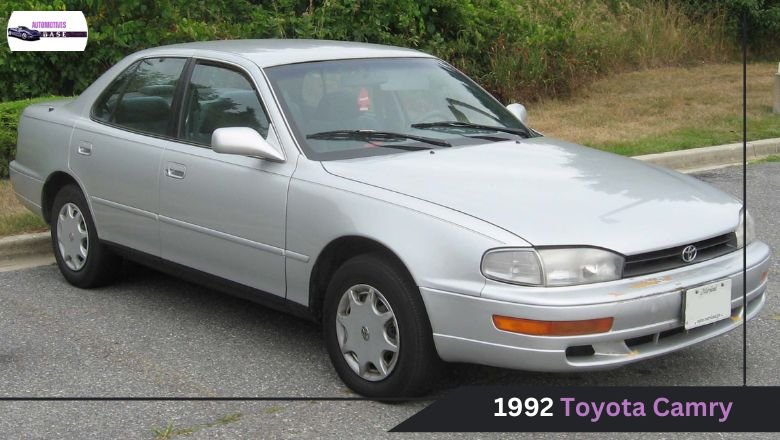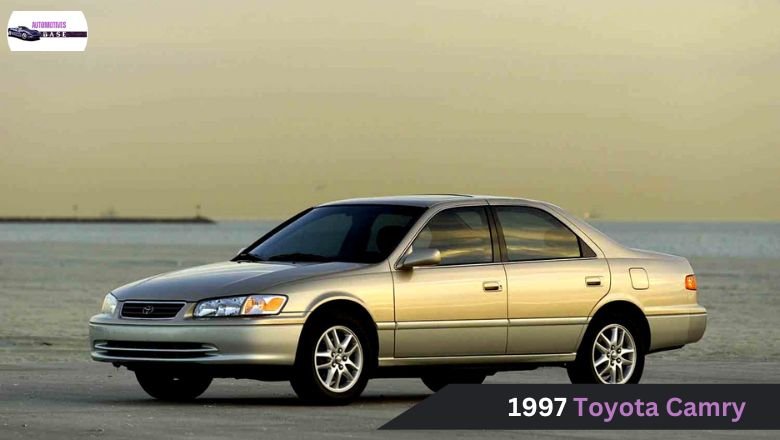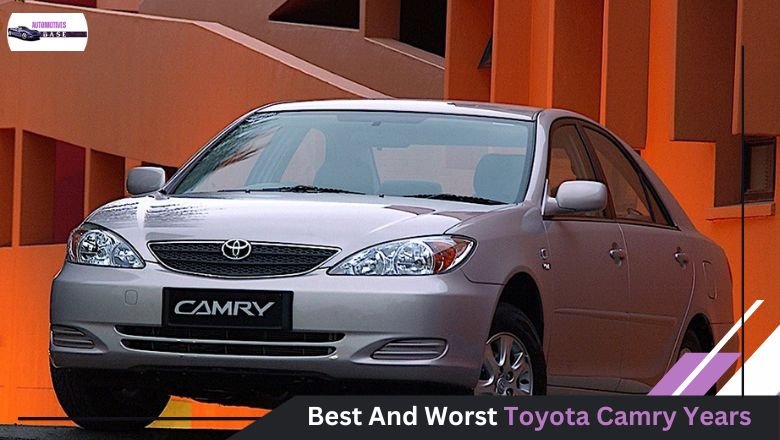The best and worst Toyota Camry years wide-body Toyota Camry of 1992 wasn’t just a mere update but a bold statement. Its sleek lines and muscular stance redefined the traditional perception of midsize sedans, injecting a sense of modernity and sophistication into its design.
This broader version enhanced the car’s aesthetic appeal and improved its overall functionality, offering passengers more interior space and comfort.
Toyota Camry (Wide Body) Generations
Here is a table that outlines the six generations of the wide-body Camry:
| Generations | Years |
|---|---|
| 1st generation (XV10) | 1992-1996 |
| 2nd generation (XV20) | 1997-2001 |
| 3rd generation (XV30) | 2002-2006 |
| 4th generation (XV40) | 2007-2011 |
| 5th generation (XV50) | 2012-2017 |
| 6th generation (XV70) | 2018-Present |
The evolution of the Camry across generations showcases Toyota’s commitment to innovation and adaptation to changing consumer needs.
Each iteration represents a leap forward in automotive engineering from the first generation’s simplistic design and basic features to the latest models with cutting-edge technology and advanced safety systems.
Toyota Camry Best, Neutral, and Worst Years
The Best & Worst Toyota Camry experts and owners agree that the 2012 model year stands out as one of the best.
- Annual maintenance costs
- Safety ratings
- Consumer Reports reliability scores
- Consumer Reports owner satisfaction scores
- NHTSA recalls, investigations, and complaints
- Edmund’s owner ratings
- JD Power owner ratings
- Kelley’s Blue Book (KBB) owner ratings
- VehicleHistory.com owner ratings
- Cars.com owner ratings

Neutral years in the automotive industry often receive little attention compared to top-performing and underperforming models. A year can offer a unique balance of reliability and performance that appeals to a specific segment of car buyers.
The significant recalls or complaints during these neutral years provide a sense of dependability that is sometimes overlooked in favor of more flashy or troubled models.
Best And Worst Years For Toyota Camry 1st Generation (1992–1996)
The first-generation Toyota Camry, fondly called the wide-body model, marked a significant departure in the midsize sedan market. As Toyota camry second global offering the iconic Corolla, the Camry stood out with its sleek design and advanced features.
Best Camry Years: 1995, 1996
This generation’s 1995 and 1996 model years showcased advanced technology for their time and represented a shift towards prioritizing safety and security in automotive design.
With features like anti-lock brakes and twin front airbags, these models set a new standard for ensuring the well-being of drivers and passengers on the road.
This focus on security highlighted the industry’s recognition of the importance of protecting lives beyond just performance and aesthetics.
The Neutral Years: 1993, 1994
Despite lacking the groundbreaking innovations of other model years, the 1993 and 1994 Camry models symbolize a moment of stability and evolution for the beloved sedan. They may not have stood out in any singular aspect, but these years demonstrated Toyota’s commitment to refining its flagship vehicle.
The gradual improvements in technology, safety features, and design choices reflect a meticulous approach that prioritized enhancing the overall driving experience rather than chasing fleeting trends.
The Worst Years: 1992
The 1992 Camry, despite its status as a pioneering model, faced a host of structural problems that tarnished its reputation. From transmission issues to reports of engine failures, it quickly spiralled into the realm of unreliability and poor performance.

Customers were left frustrated and disappointed by the many problems that arose with this model year.
Best And Worst Toyota Camry Years 2nd Generation (1997–2001)
During the second generation, from 1997 to 2001, the Toyota Camry made impressive strides in solidifying its reliability and high-performance reputation. With a sleek design and smooth driving experience, the Camry quickly became a top choice for many consumers seeking a dependable vehicle.
Toyota Camry Best Years: 1998, 2000
This generation’s 1998 and 2000 models truly set a new standard for Toyota. The enhanced interior quality brought comfort and sophistication that surpassed previous years, making each drive a pleasure.
The powertrain performance significantly improved, but the better fuel economy also showcased Toyota’s commitment to efficiency without compromising power.
The Neutral Years: 1997, 1999
The 1997 and 1999 models of the Camry may not have revolutionized the automotive industry. Still, they played a crucial role in solidifying the reputation of the Camry as a dependable and efficient vehicle.
These years can be seen as a period of refinement rather than innovation for the Camry brand, focusing on fine-tuning existing features rather than introducing groundbreaking technologies.

Despite not being flashy or groundbreaking, these models managed to strike a balance between performance, fuel efficiency, and safety that appealed to many consumers.
The Worst Years: 2001
The tumultuous journey of the 2001 Camry reveals a stark contrast to the overall successes of its generation. Plagued by persistent issues in its engine and transmission systems, this once-beloved model faced a series of setbacks that tarnished its reputation.
Reports of oil leakage, premature engine failures, and transmission hesitation cast a dark shadow over the Camry’s legacy, driving up complaints to the NHTSA.
Best And Worst Toyota Camry Years, 3rd Generation (2002–2006)
During the third-generation Camry’s production years, from 2002 to 2006, Toyota aimed to revamp the model by focusing on design and performance. The sleeker exterior and updated interior appealed to consumers seeking a more stylish and comfortable driving experience.
Camry Best Years: 2004, 2005
The 2004 and 2005 Camry models marked a significant leap forward regarding safety, comfort, and performance within the third-generation lineup. With the introduction of side-curtain airbags and an optional Vehicle Stability Control system, Toyota prioritized driver and passenger safety like never before.
These models apart were integrating an upgraded 3.3L V6 engine exclusively in the SE trim level.
The Neutral Years: 2006
Despite the 2006 Camry’s neutral status compared to its predecessors, it shouldn’t be overlooked. This model year brought notable upgrades in safety features like the Advanced Airbag System, which was a significant step forward in enhancing passenger protection.
The Worst Years: 2002, 2003
The 2002 and 2003 models of the Toyota Camry faced a barrage of issues that tarnished their reputation. With over a thousand NHTSA complaints for the 2002 model alone, concerns about vehicle speed control, brakes, and engine failures plagued many owners.

Reports of unintended acceleration and brake malfunctions raised safety alarms and highlighted a lack of reliability in these much-criticized models.
Best And Worst Toyota Camry Years 4th Generation (2007–2011)
From 2007 to 2011, the fourth-generation Camry marked a significant leap in performance and safety upgrades.
The Best Years: 2010, 2011
The 2010 and 2011 models of the fourth-generation Toyota lineup set a new standard for performance and innovation. With improved engine efficiency, drivers experienced a powerful ride while enjoying better fuel economy—a win-win situation that resonated well with consumers.
Safety enhancements in these years were also notable, with features like stability and traction control providing added peace of mind on the road. These updates improved the driving experience and contributed to an overall increase in the vehicle’s safety ratings.
The Worst Years: 2007, 2008, 2009
The automotive industry entered a new era with the generation of 2007, and hopes were high for groundbreaking advancements. The reality painted a starkly different picture, marred by many serious issues plaguing vehicles from this period.
The alarming number of NHTSA complaints and recalls underscored the widespread concerns surrounding crucial components such as engines, brakes, and structural integrity.
The widespread issues with excessive oil consumption and speed control in the fourth-generation Toyota Camry during the years of 2007–2009 brought unforeseen challenges to both drivers and manufacturers alike. Premature engine wear and failures became all too common, denting the vehicle’s reputation for reliability.
Best And Worst Toyota Camry Years 5th Generation (2012–2017)
The fifth-generation Camry (2012–2017) was a game-changer for Toyota, particularly in Japan, where it saw a significant revival in sales.
A factor behind this success was the implementation of Toyota’s Hybrid Synergy Drive system, which not only appealed to eco-conscious consumers but also showcased the brand’s commitment to innovation and sustainability.
The Best Years: 2014, 2017
For enthusiasts and practical buyers alike, the 2014 and 2017 models stand out as the defining years of this generation. The 2017 model, in particular, marked a significant leap forward regarding performance and safety features.
Equipped with a robust engine that delivers power seamlessly, advanced technology integration, and superior safety enhancements, it sets a new benchmark for its contemporaries.
The Neutral Years: 2013
Compared to its successors, the 2013 Camry may not have boasted groundbreaking innovations or design changes, but it quietly excelled in delivering a solid, dependable driving experience. This neutrality can sometimes be misconstrued as mundane; it speaks to Toyota’s commitment to consistency and refinement in their flagship sedan.
Focusing on incremental enhancements rather than radical shifts, the 2013 model year continues to hold its own in the fiercely competitive midsize sedan market.
The Worst Years: 2012, 2015, and 2016
The 2015 model year also faced significant challenges, with transmission issues being a common complaint. The inconsistent shifting and jerking motions made for a frustrating driving experience, tarnishing the overall reputation of this particular year.
In 2016, many drivers reported problems with the car’s electrical systems, including faulty sensors and dashboard malfunctions.
Best And Worst Toyota Camry Years, 6th Generation (2018–2023)
One of the strengths of the sixth-generation Toyota Camry lies in its tech-savvy features, which set a benchmark for other midsize sedans. The introduction of Apple CarPlay and Android Auto compatibility brought seamless connectivity to drivers, enhancing the overall driving experience.
The Best Years: 2022
The 2022 Camry model year sets a new standard in midsize sedans, with its groundbreaking enhancements ushering in a new era of performance and safety.
Implementing the Toyota Safety Sense 2.5 (TSS 2.5) package cements its position as a leader in passenger protection, offering an array of cutting-edge safety features that prioritize the well-being of all occupants.
The Neutral Years: 2018, 2019, 2020, 2023
The 2018, 2019, 2020, and 2023 Camry models may not have revolutionized the sixth-generation lineup, but they still offer a reliable and consistent driving experience. These years could be seen as a period of refinement for the Camry, focusing on small tweaks rather than major overhauls.
Lacking standout features or drawbacks, these models excel in their core functionality and continue to uphold Toyota’s reputation for quality and durability.
The Worst Years: 2021
The 2021 model year of the Camry presented a stark contrast to its predecessors, facing a barrage of challenges that left owners feeling less than satisfied. With consumer reports highlighting issues in reliability and overall owner satisfaction, it became evident that this iteration had missed the mark.
The various problems reported by consumers and anomalies in the fuel system, airbags, and brakes took center stage as recurring concerns.
Conclusion
The Best and Worst Toyota Camry years has had its share of ups and downs across different generations. Some years have stood out for their reliability, performance, and safety features; others have faced criticism for various issues. It is important for buyers to thoroughly research and consider the strengths and weaknesses of each generation before making a purchase decision.
The best Toyota Camry years offer a balance of style, comfort, and value for money. If you’re in the market for a used Camry, prioritize models from the most favorable years to ensure a satisfying ownership experience.
What Is The Most Reliable Toyota Camry Years?
The Toyota Camry has a reputation for being a reliable and long-lasting vehicle, with several model years standing out as particularly dependable. Among the most reliable Toyota Camry years are the 2002-2006 models, known for their solid build quality and low maintenance costs.
Which Toyota Camry Is The Safest?
The Toyota Camry has a reputation for being one of the safest vehicles in its class. The Toyota Camry with the highest safety rating is typically the model year that has the most advanced safety features and technology. In recent years, models equipped with Toyota Safety Sense (TSS) have received top marks in crash tests and safety evaluations.
What Year Was The Bad Toyota Camry?
The year that stands out as a bad year for the Toyota Camry is the 2007 model year. This particular year saw various complaints from owners regarding issues with excessive oil consumption, transmission problems, and overall lower build quality compared to other years.
Is Hyundai Sonata Also Have Worst Years?
Certain model years of the Hyundai Sonata may have experienced issues, but it’s essential to research specific years for reliability ratings and consumer feedback.

